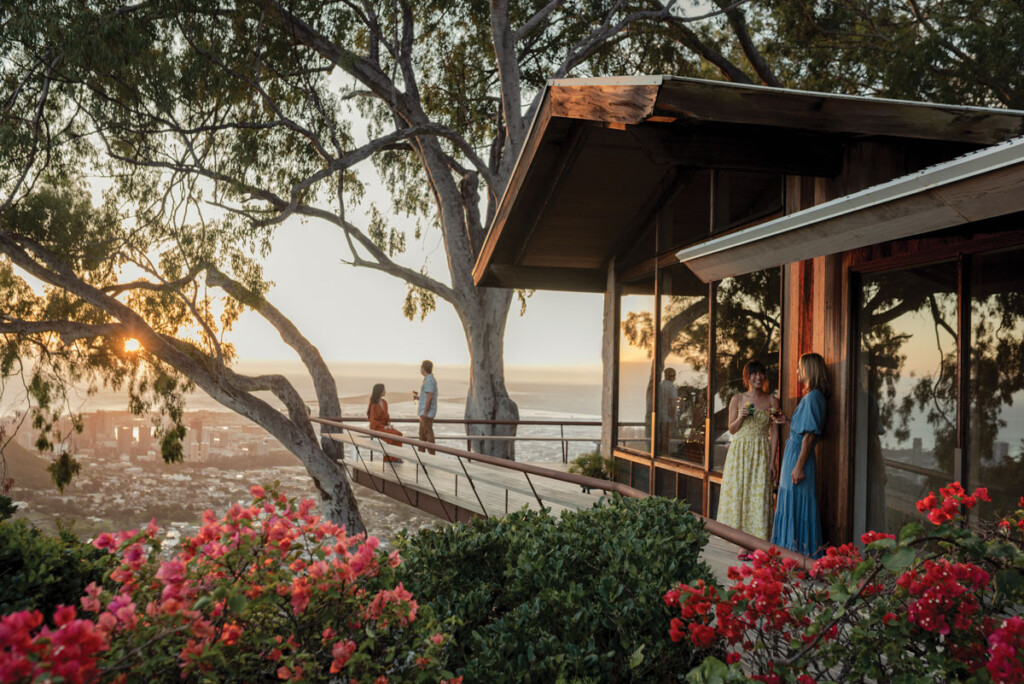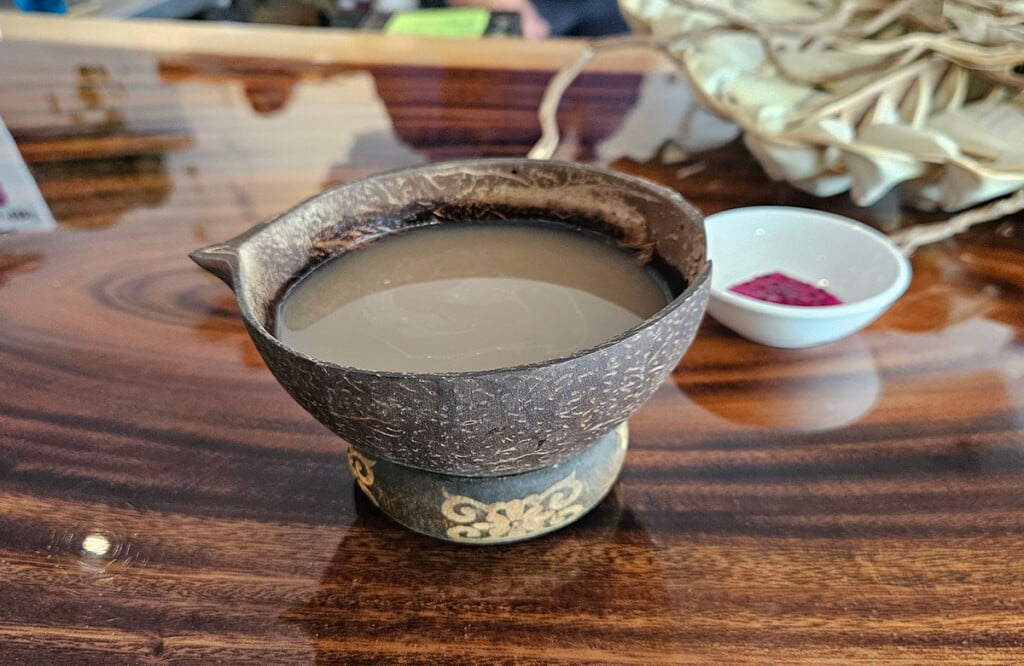New Chef Gives Vintage Cave Honolulu a French Accent
Former French Laundry chef Jonathan Mizukami returns to Honolulu as Vintage Cave Honolulu’s new chef.

Baby abalone à la Grenobloise.
Photos: Steve Czerniak
Vintage Cave Honolulu owner Takeshi Sekiguchi, a billionaire developer with a taste for caviar and oysters, seems to have St. Lawrence—the patron saint of cooks—smiling on him. Sekiguchi has snagged not one, but two Hawai‘i-born talents who are also former employees of game-changing American chef Thomas Keller. In 2012, Sekiguchi made discriminating diners take note with Chris Kajioka, when he made him an offer he couldn’t refuse at a time when Kajioka was working in San Francisco but missing his hometown. Kajioka’s résumé includes a stint as chef de partie at Keller’s Per Se in New York.

New Chef Jonathan Mizukami.Photo: Courtesy of Vintage Cave |
After putting Vintage Cave on the international food map in just a year and a half, Kajioka announced this past spring he would be leaving. (The restless chef took time off to travel, do a stage—an unpaid internship—at Jeremy Fox’s Rustic Canyon in Los Angeles, got a James Beard Foundation scholarship to stage with Pierre Gagnaire in Berlin, and at press time was slated as inaugural chef de cuisine of Michelin-starred Mourad Lahlou’s new restaurant in downtown San Francisco. Upon his return to Hawai‘i in a few months, he plans to open his own place in Kaimukī in late summer.) Honolulu’s restaurant scene was achatter with who would fill his shoes. In a case of crazy kismet, general manager Charly Yoshida tapped into the Alan Wong’s alumni network, contacting Corey Chow, who had recently resigned as sous chef at Per Se. Chow, in turn, contacted Maui-born Jonathan Mizukami, who had just handed in his resignation letter two weeks earlier after 10 years at the legendary French Laundry in Napa Valley, four of them as sous chef. He wanted to return home. So the boy who graduated from the Maui Community College culinary program and went on to Alan Wong’s and The French Laundry is back in Hawai‘i as part of Sekiguchi’s culinary fever dream.
It’s a seamless torch passing. On the surface, the restaurant is the same—the gloomy faux-ancient European wine cellar fitted with I-like-what-I-like rich-man art (no contemporary blue-chip names, though they could afford it); Vivaldi’s Four Seasons or, in this case, Tchaikovsky’s The Nutcracker Suite, on a continuous, annoying loop (“Russian Dance” is not relaxing dinner music); tables of well-heeled nihonjin; an extensive $295 daily tasting menu; alluring, painterly presentations of high-technique, French-based contemporary food on designer ceramic ware.
But look closer and you’ll see Mizukami’s fingerprints. Where Kajioka’s menu had a growing Japanese influence, thanks to Sekiguchi-sponsored research trips to Japan, Mizukami goes full-force French. The minimalist dish names have been replaced by more formal descriptions, many of them including classic Gallic sauces—bordelaise, Périgourdine, Dijonnaise. Where foie gras and osetra caviar were included on the menu, you now pay extra to satisfy your luxe cravings (for example, on the menu is a dish made with white-sturgeon caviar and, for $70 more, you can replace it with osetra caviar). If you’ve never been to The French Laundry, now’s your chance. And you don’t have to pay for a plane ticket.

Vintage Cave’s slow-roasted squash is dressed up with pumpkin seeds, ale gastrique and dates.
What were trendily called “snacks” are now referred to as “canapés” by the increasingly polished young waitstaff. And, on one visit, these preliminary bites included a tiny nest of fried ogo, topped with two pearls of hazelnut “jam.” It looked like it was plucked off a beach and was similar to eating a Triscuit, with hairy fibers tickling the tongue. This subtle nibble, along with a deviled quail egg topped with a disc of black truffle, kicks off an arc of flavors that builds over the course of the dinner.
In the hands of lesser chefs, Hawai‘i Island baby abalone can end up having to be chewed like rawhide. Mizukami tames the mollusk into tender submission and does it up à la Grenobloise—but he updates the classic fish preparation with zingy preserved lemon and Spanish capers. It sits on creamy cauliflower puree and is accented with leaf-thin shavings of cauliflower.
A “poularde en crépinette”—basically fancy chicken sausage—with Périgourdine sauce (demi-glace boosted with foie gras and truffles) gave me flashbacks to extinct New York old-school French temples of pike quenelles such as La Caravelle.
Yet Mizukami also has the restraint to let ingredients speak for themselves. Herb-roasted lamb arrived as two small hunks of red meat (one strip loin, the other tenderloin), and I mean hunks, not petite medallions. I felt like a hunter-gatherer looking at these pieces of flesh, adorned only with a little kidney-shaped pool of sauce (the menu says Dijonnaise, but this brown liquid looked nothing like the mustardy classic) and a cluster of two small gnocchi (that had the texture of mousse and the flavor of the best French fries. Ever.) and two halves of Brussels sprouts. Primal food. And, god, was it perfect. Precision cooking assured the meat was practically raw, yet warmed through, and tender as the night. It was the kind of dish that becomes a little movie in your head, reliving the moment the lamb dissolves in your mouth.
It’s de rigueur for a chef to have a take on retired French master Michel Bras’s seminal dish Le Gargouillou, which seems like a casual swath of spring meadow on the plate, but is, in fact, a very deliberate construction that offers a kaleidoscope of color and tastes. Mizukami’s “Salade de legumes du jardin,” bright with a champagne vinaigrette, is like a detail from a Fragonard painting with infant carrots, fennel, herbs, cucumbers, radishes and dots of avocado puree making a lovely composition of pastel pinks and greens.
But amid the high points are head scratchers, like matsutake mushrooms overshadowed by a deep pool of brown butter and a custard that together came dangerously close to tasting like egg white fried in butter scraped from the sides of a pan (though the circular composition is beautiful; the bits of trumpet mushroom with crisp rosemary sprinkled on top look like calligraphy). Or the gravlax of Pacific kampachi—which spurs images of a silky, unctuous treat—that turned out to be a cube of fish with the texture of an eraser. Mizukami cookes it en confit after a brief curing. Combined with the accompanying “everything bagel” crumble, it was like a micro, deconstructed fish sandwich. And if you’re going to have a play on “mac & cheese”—of which there are already a billion—it better be mindblowing. But it wasn’t. You get gemelli pasta (al dente, of course) with Parmigiano Reggiano and some ignominious bits of savoy cabbage that reminded me mostly of how Vintage Cave 1.0 made its name by elevating Caraflex cabbage to a star ingredient.
But that neat trick may happen yet again. As at The French Laundry, Mizukami has introduced a parallel vegetable tasting menu, which is where he says he can “stretch.” Humbly named “slow-roasted squash” looks like the sculptural landscape of a beautiful orange planet in a galaxy far, far away: A twisted sea slug of squash is surrounded by a visual vortex of squash puree, tiny islands of pumpkin seeds and bitter ale gastrique, and dates are reduced to a sweet, coarse sand. Mizukami is experimenting with ‘ulu (breadfruit), pairing it with things like hearts of peach palm, pickled ginger and yuzu. Who knows, maybe it will turn out to be his first signature dish.
|
|
Where Vintage Cave 2.0 has taken a big leap forward is at the end of the meal. The addition of Eddie Lopez, whom Mizukami met when the Chicago native was pastry chef de partie at The French Laundry, has resulted in desserts that finally hold their own against the savory stuff. He should just call his “Apple Tarte Tatin” “My Cool New Apple Dessert,” because its connection to the classic French upside-down tart is so tenuous. In fact, with the genius addition of baby celery leaves (along with Fuji apple sorbet, teeny vanilla cookies and candied pecans), it is more closely related to Waldorf Salad than any tart. His gateau Marjolaine, a layer fest of chocolate mousse and caramelized hazelnuts, shows he can pay respectful homage to dessert traditions, too.
Mizukami has said he wishes to build his own style on his Keller foundation. We can’t wait to see what the House of Mizukami tastes like.
Vintage Cave Honolulu, 1450 Ala Moana Blvd., Ala Moana Center, street level, 441-1744, vintagecave.com.









